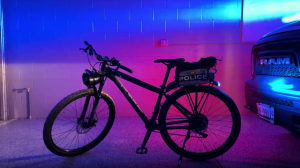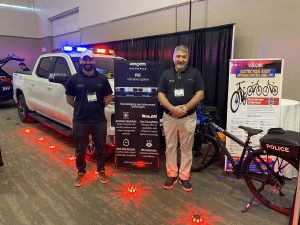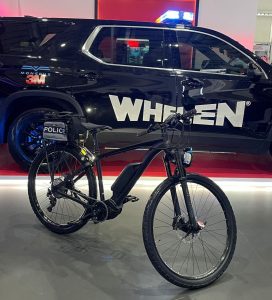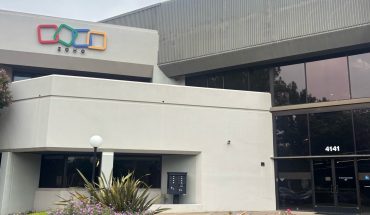Cutting-edge digital technologies and computer applications are having a tremendous impact on law enforcement, corrections, and security services – and therefore, on us.
From head to toe, from GPS to generative AI to MDFT (mobile device forensic tools), from UAVs and drones to cybertrucks and fat bikes, policing is a high-tech industry and police forces around the world and here in Canada are quite literally deploying the latest whistles and bells (and flashing lights).
The latter three technologies are specifically found on what are colloquially known as ‘fat bikes’: but more than a fancy consumer electric bike, these dedicated mobility devices are modified and souped-up to meet the evolving challenges of modern-day policing. On-board some high-tech bikes now rolling out in Windsor, Ontario, for example, are smart location tracking and emergency event tools that turn the two-wheeled transportation devices into highly-connected data gathering platforms.
As part of a one-year pilot program, the Windsor Police Service is testing out such new tech on its bikes: the newly-outfitted two-wheelers will be used to help gather real-time location data about officers, their assignments and activities, as well as providing connectivity in support of more efficient and effective assignment of officers and deployment of resources.

The Windsor Police Service is testing out new technology on its bikes: it will be used to help gather real-time location data about officers, assignments, and activities. Monerus image
The technology was developed by a growing tech firm in the Windsor-Essex region called Monerus, and the partnership was coordinated through a local tech incubator and entrepreneurial support agency, the WeTech Alliance.
Enclosed in a small box sitting on the back of a test bike, there’s a Wi-Fi transmitter and 5G wireless hub that connects via satellite back to police headquarters in real-time.
(As it happens, those police HQs are getting more high-tech, too. Announced recently by the nearby Peel Regional Police, construction is underway on its new Operational Support Facility, where real-time emergency operations and the next-gen 9-1-1 centre will be based, along with IT and records services and more, all in a brand new, highly-connected state-of-the-art facility.)
This techno-evolution of law enforcement shows how physical infrastructure, digital technology, multiple sensors, and analytical software are being combined to assist police in their duties.

New police tech tools are often shown at industry and sector events such as the Blue Line Expo and the PoliceTech Conference, both of which were held recently in Ontario.
Data-driven decision-making is an ever-growing component of the future of policing, and new tech tools are often shown at industry and sector events such as the Blue Line Expo and the PoliceTech Conference, both of which were held recently in Ontario.
Monerus and its partners were among the companies showing the latest police tech: company co-founder and project manager Khalid Saad said in a news release that the company is looking to revolutionize urban policing with their tech-enhanced bicycles.
WEtech Alliance has been working with Monerus, among with many other early-stage and start-up tech companies in the area, for more than a year on the vision.
“Monerus is very well-established; they have a great track record of supplying police forces and first responding units with this kind of tech and wanted to find a solution for local police forces in North America,” WEtech’s Director of Venture Services and Partnerships, Adam Castle, announced, saying the company was already developing a police light bar that essentially turned police cars into smart vehicles, using AI, facial recognition, and other tools to protect and support officers in challenging situations.

Monerus worked with other advanced technology companies, such as Whelen Engineering and Volcanic Bikes, while developing bikes for the WPS.
Monerus worked with other advanced technology companies such as Whelen Engineering, a leading manufacturer of emergency warning equipment – those bells, whistles, and flashing lights – used in law enforcement, aviation and elsewhere, and another U.S.-based partner, Volcanic Bikes, which makes what it calls the “toughest patrol bikes on Earth”. More than a thousand first responder organizations use its specially-manufactured, machine-tooled APBs, or Approach Patrol Bicycles.
(Of course, other police services use different products for their bike patrols: products from Pedego Canada and those bearing the Trek brand are among those designed specifically for use by police and first responders; they can cost upwards of $6,000 each.
Yet that’s a far cry from the costs associated with the latest police vehicles: cybertrucks. Based on the rugged Tesla Model Y, based upwards of $52,000, these state-of-the-art police vehicles are specifically customized for tactical, military or search and rescue missions with upgraded surveillance, communications, and computer systems packages among several sector-specific modifications.)
The modifications made by Monerus for the Windsor Police bike squad are not quite as comprehensive, but they are nevertheless valuable, according to Castle at WE-Tech Alliance. When introducing the pilot program, he told local media that “[T]hese devices are taking data and making sure the police are able to make really smart decisions with it…. [T]he officer isn’t spending their time communicating… you’ve got all of your equipment that’s reporting for you.”
Both the Windsor Police and Monerus itself will evaluate the results of the current pilot program and will look in 2025 to make further program adjustments or technical updates based on their findings.
They will undoubtedly find that technology has an impact on policing, but perhaps good and bad both.
The speed at which new technology is being integrated into police activities is often faster than the pace of legislators passing rules and regulations meant to govern its use. Facial recognition, telecom interception, and AI implementation are among the technological disciplines for which reactive social policy and guardrail legislation has been deemed necessary. Ironically, the technology developed to protect police officers can in fact expose them to other risks: privacy rules, security concerns, jurisdictional regulations.
That’s one of the findings of Toronto Metropolitan University (TMU) criminology professor Ajay Sandhu. He’s been researching how police use emerging technologies even as they must meet the challenges of adoption and regulation.
Professor Sandhu says government agencies, police oversight bodies, and technology companies, should all share responsibility for keeping tech adoption and regulation in sync, and they should be providing training and oversight to ensure emerging technology is used effectively and properly.
As easy as riding a bike.
-30-



